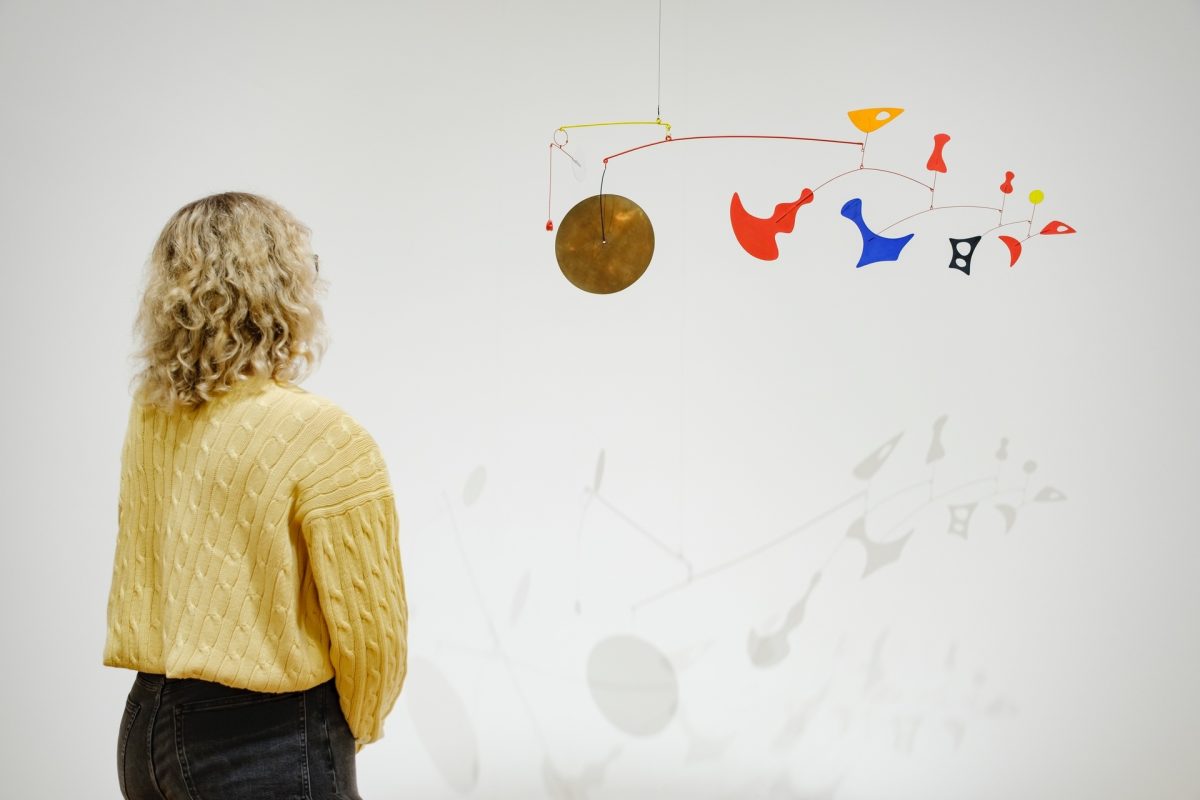Calder Smartphone Tour: Dispersed Objects with Brass Gong
“You have weight, form, size, color, motion and then you have noise.”
– Alexander Calder
Alexander Calder’s mobiles are recognized for their subtle movements, but their innovative use of sound is lesser known. Of over 22,000 artworks attributed to Calder, scholars have identified dozens of sound-producing mobiles. Beginning in the 1930s, Calder used sound in his abstract objects as a means to enhance ‘disparity’ within a composition. His most recognizable sonorous objects feature gongs, which he developed in earnest in the 1940s and 1950s.
Following its creation in 1948, Dispersed Objects with Brass Gong hung in the artist’s Roxbury studio, where incoming winds from the Connecticut countryside would ‘compose’ an unpredictable musical backdrop as he worked. A glimpse into this experience is offered in the Herbert Matter film Works of Calder (1950), with music by John Cage, in which elements of Dispersed Objects with Brass Gong slice through space. In the following decade, the mobile was presented as part of Philadelphia Collects 20th Century at the Philadelphia Museum of Art before being acquired by the Shirley family in 1999.
Sound objects like Dispersed Objects with Brass Gong express the possibilities that Marcel Duchamp recognized in Calder’s mobiles in 1949: “The symphony is complete when color and sound join in and call on all our senses to follow the unwritten score. Pure joie de vivre. The art of Calder is the sublimation of a tree in the wind.”
Find out if you can hear the subtle ‘ding’ of Dispersed Objects with Brass Gong by visiting Calder: In Motion, The Shirley Family Collection at SAM. Until then, you can learn more about this work from SAM Susan Brotman Deputy Director for Art José Carlos Diaz and Calder Foundation President Alexander S. C. Rower by tuning in to the eighth stop on the exhibition’s free smartphone tour via our SoundCloud.
Dispersed Objects with Brass Gong, 1948
JOSÉ CARLOS DIAZ: One of the joys about Calder’s work is that one must be prepared for the unexpected…
NARRATOR: José Diaz:
JOSÉ CARLOS DIAZ: … whether you visit the exhibition and you see objects moving—or if you hear sounds. And so this is a wonderful example of one of Calder’s works that actually contains sound.
ALEXANDER S. C. ROWER: This particular work is one of my favorite works in the Shirley Collection.
NARRATOR: Sandy Rower:
ALEXANDER S. C. ROWER: Every object has an extraordinary shape except for the white disc—which, the white disc has the kind of purpose of being almost a rudder to drive the hammer, which is this red coil that strikes the gong. Even just people circumnavigating a gallery will activate the mobile, and it will occasionally give a little bright, you know, ‘ding.’
NARRATOR: Calder’s use of sound can be related to his love of music.
ALEXANDER S. C. ROWER: Calder was quite obsessed with music. He loved to dance. He was a famous dancer actually. If he was at a party, he would dance with a partner and then wear them out completely and then choose another partner and wear that person out completely. Which I witnessed as a young boy, of course, but much more famously was in the ‘20s and the ‘30s and ‘40s when he was out doing such things, you know.
NARRATOR: Here, the musical vibration is a way of drawing us into the work.
JOSÉ CARLOS DIAZ: There is a possibility it may never make sound during its presentation at the Seattle Art Museum, but the moment of surprise awaits.
– Lily Hansen, SAM Marketing Content Creator
Image: Installation view of Calder: In Motion, The Shirley Family Collection, Seattle Art Museum, 2023, © 2024 Calder Foundation, New York / Artists Rights Society (ARS), New York, photo: Alborz Kamalizad.
